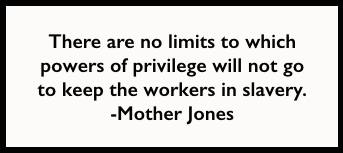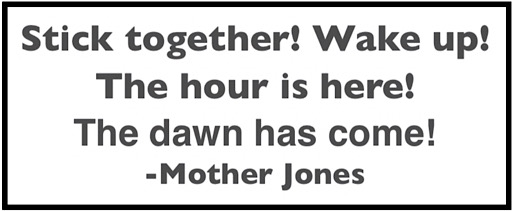 —————
—————
Hellraisers Journal – Friday January 16, 1914
Houghton, Michigan – Cheering Crowd Meets Moyer and Tanner at Station
From the Miners Magazine of January 15, 1914:
From the Miners’ Bulletin of January 9, 1914:
 —————
—————
Hellraisers Journal – Friday January 16, 1914
Houghton, Michigan – Cheering Crowd Meets Moyer and Tanner at Station
From the Miners Magazine of January 15, 1914:
From the Miners’ Bulletin of January 9, 1914:
 —————
—————
Hellraisers Journal – Monday December 1, 1913
Annie Clemenc, Heroine of Michigan’s Copper Country Strike
From the International Socialist Review of December 1, 1913:
“BIG ANNIE”
IN the Calumet strike region they are calling Annie Clemenc the American Joan of Arc. Annie Clemenc is a miner’s wife. A Croatian [Slovenian], she was born in this country and educated in the school at Calumet. If she were dressed in fashion people would turn to look at her if she walked down State street or Fifth avenue. Even in her plain dress she is a striking figure. Strong, with firm but supple muscles, fearless, ready to die for a cause, this woman is the kind all red-blooded men could take off their hats to.
I suppose Annie Clemenc knows what it is to go hungry, but I don’t believe all the millions of dividends ever taken out of the Calumet & Hecla mine could buy her.
The day when the soldiers rode down the flag Annie Clemenc stood holding the staff of that big flag in front of her, horizontally. She faced cavalrymen with drawn sabers, infantry-men with bayonetted guns. They ordered her back. She didn’t move an inch. She defied the soldiers. She was struck on her right wrist with a bayonet, and over the right bosom and shoulder with a deputy’s club.
“Kill me,” she said. “Run your bayonets and sabers through this flag and kill me, but I won’t go back. If this flag will not protect me, then I will die with it.”
After the parade one morning Annie Clemenc came up to the curb where President Moyer was standing. I was there.
Looking up at him she said:
“It’s hard to keep one’s hands off the scabs.”-From the Miners’ Bulletin.
“Big Annie” has been leading the parades of the striking miners to which she walked early every morning from seven to ten miles. The women have been especially brave and class consciousness in this copper war. And the Finns, who have been educated in the principles of Socialism, are lending a militant character to the struggle that helps much to developing the staying powers of the men
[Emphasis added.]
 —————
—————
Hellraisers Journal – Wednesday November 12, 1913
Michigan Copper Country – Citizens Alliance Formed to Combat W. F. M.
From The Calumet News of November 10, 1913:
 —————
—————
Hellraisers Journal – Monday September 15, 1913
Calumet District, Michigan – Annie Clemenc, Maggie Aggarto
and Four Other Women Arrested on the Picket Line
From The Calumet News of September 11, 1913:
 —————-
—————-
Hellraisers Journal – Saturday September 6, 1913
Kearsarge, Michigan – Young Margaret Fazekas Shot Down by Deputies
From The Calumet News of September 2, 1913:
[…..]
Saturday September 6, 1913
Keweenaw Peninsula, Michigan – Girl, fourteen, shot in head, not expected to live.
Disturbing stories of violence against the women and children in the Michigan Copper Country Strike Zone are making there way out of the area. A young fourteen-year-old girl was shot in the head when deputies opened fire on a strikers’ parade. The girl is Margaret Fazekas. She was shot near the Kearsarge shaft during the Labor Day parade by Sheriff Cruse’s armed deputies.She was rushed to the hospital and was not expected to live.
On September 4th, a guardsmen was so enraged by a woman waving a broom and cursing at him that he threatened her:
I’ll fix you so that you won’t handle a broom anymore!
The guard attempted to tie her to his horse for the purpose of dragging her along the ground. However, his plan was thwarted when more women came running to her aid, pelting the guardsmen with rocks and sticks.
Militiamen routinely ride their horses into the strikers who gather for any reason, and, by this practice, a small child has been injured in Laurium.
But it is for the children that the strike must go on, for as one woman said pointing to her children:
These are the ones we are striking for. You don’t want to see them bent and crippled before their time, do you?
Another woman joins the picket lines even though her husband is dead, killed in the mines leaving her with four young children. She said:
Men killed, company pay nothing. Many families get poor by strike, but maybe men win. I hope so.
—————
 —————
—————
Hellraisers Journal – Wednesday July 16, 1913
Hancock, Michigan – Organized Copper Miners Request Meeting with Operators
From The Brooklyn Daily Eagle of July 8, 1913:
Letter from Copper District Union (W. F. of M.) to C. & H. Mines,
James MacNaughton, Manager:
Copper District Union
Western Federation of Miners
Box 217, Hancock Mich., July 14, 1913To the Calumet & Hecla, Tamarack, Ahmeek, Allouez, Centennial, Superior, Laurium, Isle Royale, and all other mining companies connected with and under the management of Calumet & Hecla; James MacNaughton, manager.
GENTLEMEN: Your employees, organized into various unions of the Western Federation of Miners, have decided by referendum vote to ask that you meet their representatives in conference on some day during this month for the purpose of discussing the possibilities of shortening the working day, raising wages, and making some changes in the working conditions.
The men working in your mines are dissatisfied with the wages, hours, and other conditions of employment. Realizing that as individuals they would not have sufficient strength to correct these evils or to lessen the burden placed upon them, they have organized into the local unions of the Western Federation of Miners, and through the local unions they have formed one compact body of the whole copper district, with an understanding and hope that from now on they may be enabled to sell their labor collectively with greater advantages for themselves as well as their employers.
While the men have decided that they must have greater remuneration for their services and that the working day must be shortened, it is not their or our desire that we should have a strike, with all the sufferings that it is bound to bring to them, to the employers, and to the general public. On the other hand, we earnestly hope that the questions that have arisen between us would be settled amicably, with fairness and justice to both sides. Should you have the same feeling, we believe that the friendly relations that have existed between you and your employees in the past will continue in the future.
However, should you follow the example given by some of the most stupid and unfair mine owners in the past, the men have instructed us by the same referendum vote to call as strike in all the mines owned and controlled by your company.
We deem it unnecessary to set forth the facts and reasons for the demand for higher wages, shorter hours, and other things, in this letter, as we intend to do that in the conference – should you be fair enough to meet us.
We hope you realize that labor has just as much right to organize as capital, and that at this age these two forces, labor and capital, while their interests are not identical, must get together and solve the problems that confront them.
We expect to have your answer not later than on the 21st of this month. If you agree to meet us our representatives will be ready for a conference on any day and at any place you may choose; provided you do not set the date any later than the 28th of this month. Your failure to answer this will be taken as proof that you are not willing to meet us and to have the matters settled peacefully.
Hoping to hear from you soon, we remain,
Respectfully, yours.
Dan Sullivan,
President Copper District Union
of the Western Federation of Miners
C.E. Hietala,
Secretary Copper District Union
of the Western Federation of Miners[Emphasis added.]